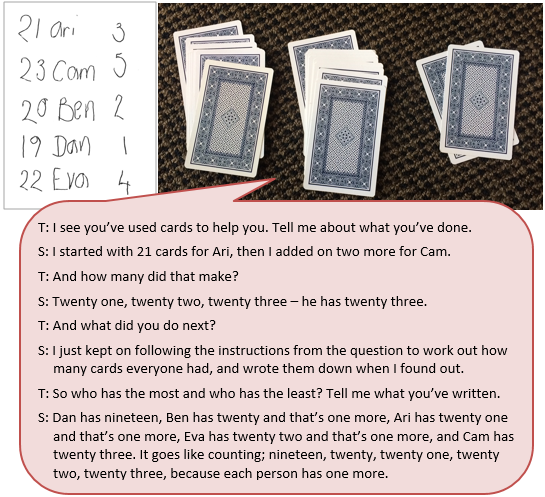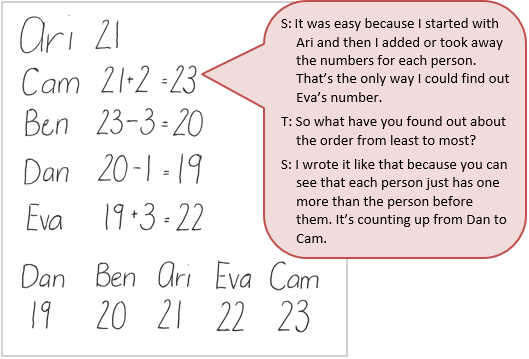Card collections
The purpose of this activity is to engage students in logical thinking and simple addition and subtraction.
This activity assumes the students have experience in the following areas:
- Counting forwards and backwards in ones from any number.
- Partitioning and regrouping numbers to make calculation efficient.
- Equally sharing whole number amounts.
The problem is sufficiently open ended to allow the students freedom of choice in their approach. It may be scaffolded with guidance that leads to a solution, and/or the students might be given the opportunity to solve the problem independently.
The example responses at the end of the resource give an indication of the kind of response to expect from students who approach the problem in particular ways.

Ari, Ben, Cam, Dan and Eva are counting their card collections.
Ari has 21 cards. Cam has 2 more than Ari. Ben has 3 fewer than Cam and 1 more than Dan who has 3 fewer than Eva.
How many cards does Eva have?
Put the children’s names in order from the person with the fewest cards to the person with the most.
Note to teacher: This activity requires materials for illustration. Playing cards could be used, or could be represented by counting materials such as counters.
The following prompts illustrate how this activity can be structured around the phases of the Mathematics Investigation Cycle.
Make sense
Introduce the problem. Allow students time to read it and discuss in pairs or small groups.
- Do I understand what I need to do? (Find the number of cards each person has.)
- Do I understand the meaning of the words? (Students will need support with words like ‘more’, ‘fewer’, and ‘order.’.)
- What maths will be useful to solve this problem?
- What will an answer look like? (The answer will be the number of cards that each person has. It will also include clear working to show how the answer was found.)
Plan approach
Discuss ideas about how to solve the problem. Emphasise that, in the planning phase, you want students to say how they would solve the problem, not to actually solve it.
- What strategies will be useful to solve a problem like this? (Acting out, drawing a diagram, making a physical model, and writing equations are all possible strategies.)
- Do I have some idea of the number of cards each person will have? How?
- What numbers and operations will I use? How might I record those operations?
- What tools (digital or physical) could help my investigation?
Take action
Allow students time to work through their strategy and find a solution to the problem.
- Is my strategy working or do I need to change what I am doing?
- Can I be more efficient? Do I need to use physical objects or will number work?
- Have I shown my workings in a step-by-step way?
- Is the working clear so I keep track of where I am up to?
- How can I express my solution using diagrams, numbers, and words?
- Have I use all the information or has some information been missed?
Convince yourself and others
Allow students time to check their answers and then either have them pair share with other groups or ask for volunteers to share their solution with the class.
- Is my working clear for someone else to follow?
- Did others get the same answer? Did they use the same strategies as me?
- How would I convince someone else I am correct?
- Is my solution expressed in a mathematical way, such as with numbers and equations?
- Can I come up with a general strategy that works on these kinds of problems?
Examples of work
Work sample 1
The student uses a physical model (playing cards) to make collections for each person in the problem.
Click on the image to enlarge it. Click again to close.
Work sample 2
The student uses addition and subtraction equations to find the number of cards for each person in the problem.

